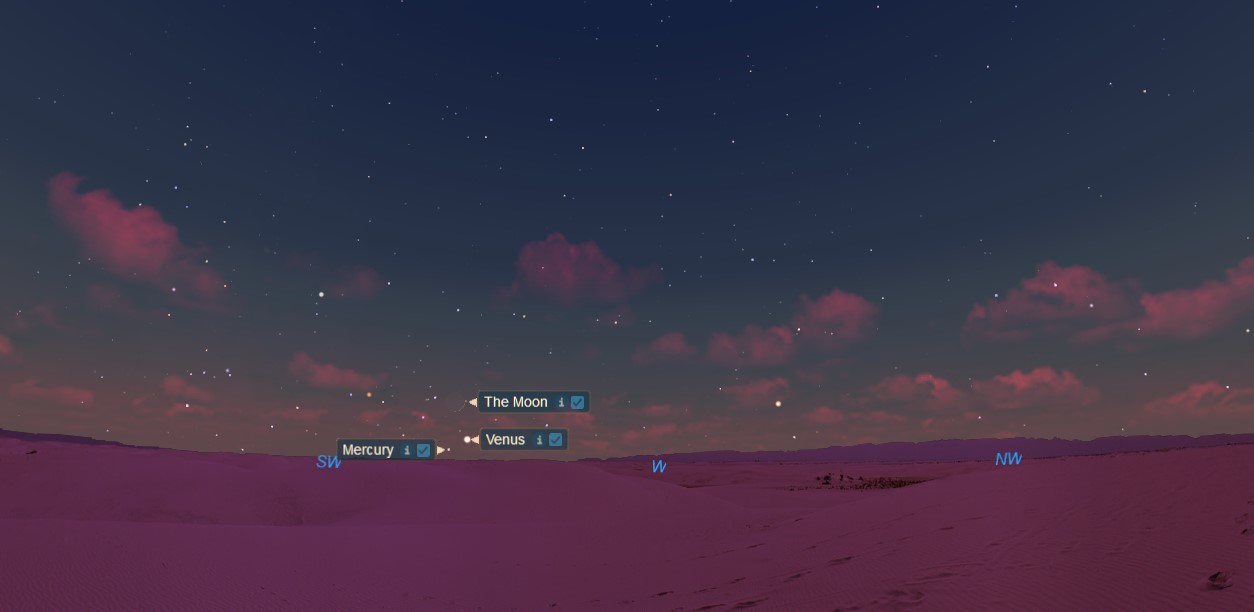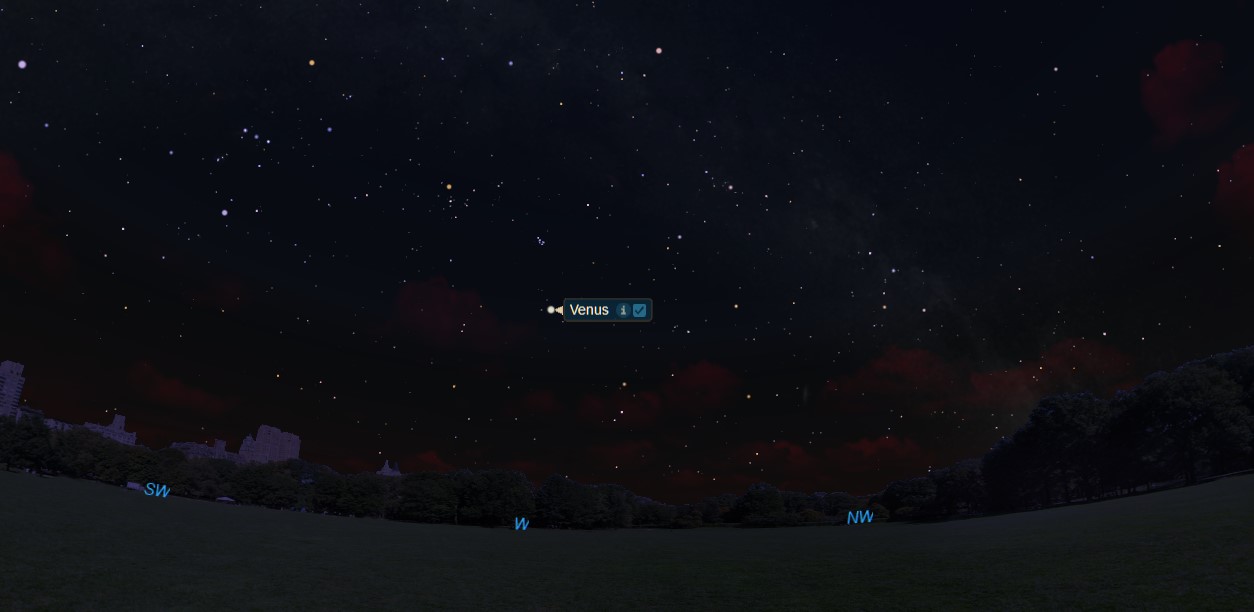
After an absence of more than a year, the most brilliant planet returns to the evening sky.
Back on Aug. 14, Venus passed superior conjunction, appearing to go behind the sun as seen from Earth. Since then, Venus has remained invisible, buried deep "behind" the sun. The planet has been on a slow, progressive journey, moving toward the east and slowly inching away from the sun. Finally, this week, Venus should emerge as an evening "star" very low in the western sky during twilight.
On Monday evening (Oct. 14), the planet will set about 18 degrees south of due west (10 degrees is roughly equal to the width of your fist held at arm's length) about 40 minutes after sunset. However, while it's likely that only experienced observers will be able to spot the planet then, by Oct. 28, visibility will have increased to 55 minutes, giving skywatchers more time to catch a glimpse.
Mercury and the moon rendezvous on Oct. 29
Here is a challenge to all skywatchers: On the evening of Oct. 29, try to use binoculars to spot the planet Mercury in the night sky about 30 minutes after sunset. Mercury will be about 3 degrees to the lower left of Venus, with the two planets hanging a few degrees above the west-southwestern horizon.
Situated about 4 degrees above the two planets on this same evening, a very thin crescent moon will be easier to see, just about 1.8 days past its new phase. On this night, Mercury will be visible with the naked eye for those in the southernmost U.S. at magnitude +0.3. In that region, the planet will set nearly an hour after the sun. For observers at the equator, Mercury will set as twilight ends, while, for Southern Hemisphere observers, Mercury will put on an excellent evening show later on.
Venus' time to shine
Venus will continue to swing east of the sun in November. The planet will become extremely easy to see in the west-southwest evening sky. Appearing as a brilliant-white star-like object with magnitude -3.9, by Nov. 3, our planetary neighbor will set at least an hour after the sun does. Venus will begin to rise higher in the western sky every evening, mimicking a modern-day "Christmas Star" and continuing to shine prominently throughout the winter and early spring. By New Year's Day, Venus will set as late as 2.5 hours after sunset.
Venus will arrive at its greatest elongation, or greatest angular distance, on March 24, when it will reach 46.1 degrees to the east of the sun. From then on into mid-April, the planet will set over 4 hours after the sun. It will be brightest in midspring as it heads back down toward the sun, reaching its greatest brilliancy on April 28, at magnitude -4.7. In fact, Venus will be so bright at this time that you will be able to spot it with the naked eye even in the afternoon, if the sky is a deep blue and there is no haze. After twilight ends, at a really dark site, skywatchers may also be able to spot Venus casting faint, yet distinct shadows.
Get the Space.com Newsletter
Breaking space news, the latest updates on rocket launches, skywatching events and more!

Venus shrinks and grows
Between now and May 2020, repeated observation of Venus with a small telescope will reveal the complete range of the planet's phases and disk sizes. Venus currently appears practically full (96% sunlit on Monday evening) and thus appears as a tiny, dazzling, half-lit or gibbous disk. The planet will become noticeably less gibbous by midwinter.
By the last week of March, Venus will appear as a half-moon shape. Then, for the rest of the spring, it will appear as a large crescent as it swings near the Earth. Those skywatching with telescopes will be able to see that, while the Earth-Venus distance is decreasing, the apparent size of Venus' disk will grow, doubling by March 13. Venus will double again in size on May 5, when its large crescent shape should be easily discernible, especially if you're using steadily held 7-power binoculars.
As May progresses, Venus will get rapidly lower in the sky during twilight, and it will begin to disappear. At the beginning of the month, the planet will be almost 40 degrees high in the west at sunset but will plummet to a sunset altitude of only around 7 degrees by month's end (for midnorthern latitudes). Venus will then quickly fade, vanishing completely from view during the final days of May.
Passing between Earth and the sun on June 3 during what is known as an inferior conjunction, it will reemerge as a "morning star" during the third week of June, appearing just above the east-northeast horizon. Climbing progressively higher each morning, Venus will then shine very prominently in the morning sky through the late fall of 2020.
- Rare Photos: Jupiter's Triple-Moon Conjunction in Pictures
- 'Earthshine' Lights the Way to a Saturn Moon in Stunning Night-Sky Photo
- Jupiter Shines Over New York City in Gorgeous Skywatcher Photo
Joe Rao serves as an instructor and guest lecturer at New York's Hayden Planetarium. He writes about astronomy for Natural History magazine, the Farmers' Almanac and other publications, and he is also an on-camera meteorologist for Verizon FiOS1 News in New York's lower Hudson Valley. Follow us on Twitter @Spacedotcom and on Facebook.

Join our Space Forums to keep talking space on the latest missions, night sky and more! And if you have a news tip, correction or comment, let us know at: community@space.com.

Joe Rao is Space.com's skywatching columnist, as well as a veteran meteorologist and eclipse chaser who also serves as an instructor and guest lecturer at New York's Hayden Planetarium. He writes about astronomy for Natural History magazine, Sky & Telescope and other publications. Joe is an 8-time Emmy-nominated meteorologist who served the Putnam Valley region of New York for over 21 years. You can find him on Twitter and YouTube tracking lunar and solar eclipses, meteor showers and more. To find out Joe's latest project, visit him on Twitter.
